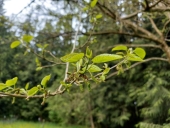
 3
3











 2
2




Moderator, Treatment Free Beekeepers group on Facebook.
https://www.facebook.com/groups/treatmentfreebeekeepers/





 5
5












 5
5




 3
3




Moderator, Treatment Free Beekeepers group on Facebook.
https://www.facebook.com/groups/treatmentfreebeekeepers/





 4
4




Michael Cox wrote:A very experience gardener/tree surgeon friend of mine insists that mulberries should not be pruned back into old wood anytime they are in leaf, as the wood continues to "bleed". I haven't tested it myself, but I have done light pruning of one year old wood at various times of year with no ill-effect.
I think, as you say, that there is a lot of inherited wisdom that amounts to little more than "I did that once or twice and it worked" - but probably under totally different conditions.







 3
3




r ranson wrote:I have about a dozen different kinds of mulberry trees, but mostly I raise alba for silkworm food. Most advice has us pollarding or coppicing these trees. So I've tried both.
I've tried the coppicing methods (on non-grafted trees) of below the earth, at ground level, and leaving the ankle-high stump. I've also pollard a few trees so they are about shoulder height. I've also tried the different times of year the books recommend for moriculture (growing of mulberry trees) from fall, winter, and early spring.
The books all swear that this will double to quadruple leaf production.
And yet, I get about 1/10th the growth and leaf harvest of the trees I didn't coppice or pollard of the same age.
Is there some sort of trick to this? I've never had any problems coppicing other varieties of trees on the farm.
Is it because we have frost in the winter? And yet, a lot of traditional silk production locations get a much harder winter than we do.
We have a Mediterranean climate where it rains all winter and doesn't rain at all in the summer. The mulberries don't seem to need any irrigation but the ones that do the best are near the chicken yard so they get a bit of moisture from rinsing out the chicken water each day.
If I harvest leaves and branches of the Alba past August I get a lot more dieback over winter than if I don't harvest that late in the summer.
So is coppicing mulberries just not a thing I can do with my climate or is there some sort of trick I'm missing?








 2
2







|
My pie came with a little toothpic holding up this tiny ad:
Support permies and give beautiful gifts to gardeners: permaculture playing cards.
https://gardener-gift.com/
|









